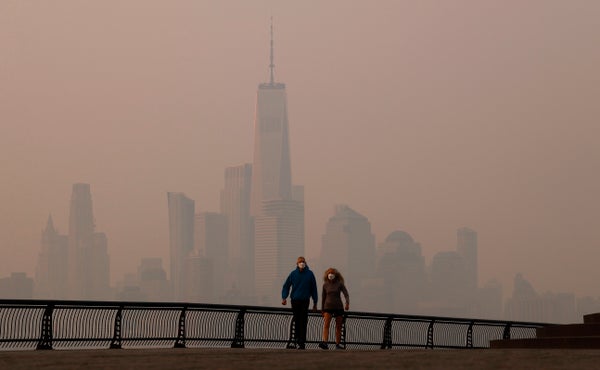CLIMATEWIRE | Wildfires are still raging in eastern Canada, even as much of their smoke has dissipated from the northeastern United States.
And as long as those fires continue burning, there's a risk the smoke “may simply be directed towards other areas of the U.S.," according to the National Weather Service.
The episode is a wake-up call for the East Coast, which has far less experience with wildfire smoke than the highly flammable West. Shrouded in haze, places like New York and Washington, D.C., experienced their worst air pollution on record last week — and got a possible glimpse of their future in a changing climate.
“We know that the weather conditions that are triggering these events — they are getting more frequent and more severe,” said Yan Boulanger, a research scientist in forest ecology with the government agency Natural Resources Canada.
While western Canada has seen more intense wildfires in recent years, researchers are still teasing out how climate change will affect blazes in eastern Canada. A 2018 study, which looked a fire trends across the country since the 1950s, found no clear trends in the region.
But that study is already a bit out of date, said Xianli Wang, a fire research scientist with Natural Resources Canada and one of the study’s authors. It doesn’t account for the last seven years of data, meaning there could be new emerging trends that researchers haven’t yet identified.
After this year’s severe fire season, Wang said, scientists may revisit the analysis to see what has changed.
Eastern Canada is generally wetter and sees fewer blazes than its western counterpart. But this year began differently. Unusually dry conditions in May, coupled with record-breaking heat at the end of the month, created a surplus of dry fuel. A series of thunderstorms then provided the spark — lightning — to ignite the tinder.
“It was kind of a perfect storm that arrived at the end of the month of May for Quebec,” Boulanger said.
Hundreds of blazes have so far burned more than 17,000 square miles across the country, according to the Canadian Interagency Forest Fire Centre. That’s more than 10 times the average burned area for this time of year.
Around 200 of those fires are burning in Quebec and Ontario.
Research suggests that the fire season will worsen in the coming decades as the climate changes. A 2022 study, for instance, found that the Hudson Plains region — which includes parts of Quebec and Ontario — will likely see the number and size of wildfires increase faster than most other regions of the country.
Wang noted that another 2022 study also suggested that “with the changing climates, we may see greater magnitude changes in the east than in the west."
Researchers can link individual extreme weather events, including wildfire, to climate change through so-called attribution studies. Until one is conducted for this year's fires, it’s unclear to what extent they were influenced by global warming.
Still, experts said such severe blazes are a harbinger of the future — and one that eastern Canada may not be prepared for, Boulanger warned.
For instance, many communities in western Canada follow the guidance from FireSmart, a national program designed to help residents prevent, mitigate and prepare for wildfires. Such programming is implemented less frequently in the eastern provinces, Boulanger said.
But if the region burns more frequently in the future, he said, communities may want to start preparing now.
“The main thing is that people just have to be aware of the risks, that’s the first step,” he said. “And then once we have identified vulnerabilities, we can have mitigation strategies to cope with those vulnerabilities.”
Reprinted from E&E News with permission from POLITICO, LLC. Copyright 2023. E&E News provides essential news for energy and environment professionals.
